Outline
- Introduction
- What Is IP66 Certification — And Why Is It Critical for Outdoor Lighting?
- Which Tests Were Performed on Long-Join’s Zhaga Receptacles to Achieve IP66?
- Why Did Long-Join Choose to Pursue IP66 Certification for Its Zhaga Bases?
- What Features Make Long-Join’s IP66 Zhaga Receptacles Stand Out?
- Extensive Long‑Join Product Range
- How Does IP66 Certification Future-Proof Zhaga Sockets in Smart Lighting?
- Why Is IP66 More Than Just a Rating — But a Global Quality Benchmark?
- How can you request LongJoin IP66-Certified Samples?
- The Bottom Line
Smart cities need smart lighting — and that means reliable components. Zhaga receptacles are at the core of modular outdoor lighting systems. But exposure to rain, dust, and extreme weather can easily compromise performance.
That’s where IP66 certification comes in. It’s not just a technical label — it’s a real-world shield against failure. In this article, we’ll explore why this rating matters and how Long-Join delivers it.

What Is IP66 Certification — And Why Is It Critical for Outdoor Lighting?
The IP code is defined in IEC 60529. It rates how well enclosures fend off solids and liquids. Manufacturers use these ratings to guarantee real-world durability.
Urban environments hit fixtures with more than rain:
- Heavy storms bring high-pressure water impact.
- Construction dust and pollution ingress.
- High-pressure cleanings and detergent sprays.
IP66 ensures photocontrol receptacles stay sealed. That keeps internal electronics dry, functional, and long-lasting.
DEKRA is the only global body authorized to certify IEC 60529 ratings. Their stamp confirms the product has passed lab tests. That gives engineers and buyers real confidence, not just a claim.
Here is a table comparing different IP ratings for outdoor lighting components.
| IP Rating | Dust Protection Level | Water Protection Level | Common Use Case |
| IP65 | Complete dust protection | Low-pressure water jets | Mid-range streetlights |
| IP66 | Total dust-tight | Strong/high-pressure water jets | Smart lighting + harsh environments |
| IP67 | Total dust-tight | Temporary immersion in water | Flood-prone or coastal zones |
| IP68 | Total dust-tight | Continuous submersion | Underground or marine lighting |
Dust Testing
The first “6” means dust-tight. No dust at all can enter the enclosure, even fine particles. For outdoor lighting, that matters. Dust buildup can harm LED drivers, photocell sensors, and connectors. IP66 ensures fixtures stay clean and functional over time.
Water Testing
The second “6” means protection from powerful water jets. Tests use a 12.5 mm nozzle at ~100 kPa, delivering ~100 L/min for 3+ minutes from all angles. This simulates heavy rain or cleaning jets. IP66 ensures the outdoor lighting control resists intense weather.
Which Tests Were Performed on Long-Join’s Zhaga Receptacles to Achieve IP66?
Long‑Join’s Zhaga receptacles are tested under the IEC 60529 standard, first released in 1989 and updated through amendments A1:1999 and A2:2013.
Key clauses used include:
- Clause 13.6 for dust-tight protection (IP6X)
- Clauses 14.2.6 & 14.3 for high-pressure water jet resistance (IPX6)
Dust Test Method (IP6X)
Street light controllers are placed inside a sealed dust chamber. A vacuum drew air through at up to 2 kPa until 80 enclosure volumes had cycled, lasting at least 3 hours. Units were energized during the first minute to replicate operational conditions. Post-test inspections confirmed zero dust ingress, meeting the ‘dust-tight’ requirement.
Water Jet Test Method (IPX6)
Following the dust test, light sensor switches are sprayed clean, then dried and reapplied with power. They were subjected to a 12.5 mm nozzle delivering ~100 L/min of water at ~100 kPa from a 2.5–3 m distance, for at least 3 minutes per square meter. Water jets came from all angles to simulate extreme rainfall, street wash-down, or pressure cleaning.
After dust and water tests, each sample was opened for visual examination.
Findings showed:
- No particles in internal compartments
- No water contact on live components
- No leakage paths or seal failures
This confirms full IP66 compliance—sealed against dust and powerful jets. Three representative combinations of Long‑Join Zhaga components were tested. Tested models include the JL‑700 series, JL‑770 series, JL‑701J, JL‑711J, JL‑731J, JL‑741J, JL‑776J, and others. Long‑Join states these samples cover the full range due to structural similarity, gaskets, and sealing designs.
Why Did Long-Join Choose to Pursue IP66 Certification for Its Zhaga Bases?

Zhaga sockets and switches face harsh realities: heavy rain, airborne dust, and salt corrosion. Unsealed components let in moisture and grit. This damages LEDs, photo switch sensors, and communication modules over time. Long‑Join aimed for IP66 to shield products from these exact threats.
Also, smart city tenders in North America and Europe often set IP65+ as a minimum requirement. Procurement specs explicitly require documented test reports. Without IP66 certification, bids can be rejected early. Long‑Join gained IP66 to meet these standards and stay competitive in global projects.
IP66 and Zhaga Book 18 Modularity
Zhaga Book 18 ensures plug‑and‑play modules fit any certified luminaire. But modularity brings exposure risks at seams and gasket interfaces. IP66 sealing ensures those points stay watertight and dust‑proof.
What Features Make Long-Join’s IP66 Zhaga Receptacles Stand Out?
Long‑Join builds sockets and switches compatible with Zhaga Book 18, ANSI C136.41, and D4i standards. The JL‑700 series meets Zhaga Z‑LEX‑R and Z‑LEX‑C interface specs.
That ensures plug‑and‑play interchange with luminaires and sensors certified across all major systems. By spanning these standards, Long‑Join simplifies integration for manufacturers and cities.
Extensive Long‑Join Product Range
Long‑Join offers many Zhaga models: JL‑700, JL‑770, JL‑701J, JL‑741J, and more. There are versions with and without cables, locking caps, and PBT baseplates. Here are some important characteristics of these products:
- Most of them are ANSI‑compatible, a Z10 Key A variant with a locking screw. This modularity supports diverse installation needs—from street poles to area lights.
- Long‑Join uses industrial‑grade gaskets, sealed baseplates, and screw locks. The JL‑770W model uses rubber gaskets, zinc alloy lock nuts, and PBT housings to ensure IP66 sealing.
- Long‑Join’s Haiyan factory covers 38,000 m² and is ISO 9001‑certified. It runs three advanced production lines with automated assembly, testing, and inspection. Each unit undergoes raw material checks, in‑process sampling, final inspection, and pack‑out verification. This rigorous system guarantees consistent IP66 reliability
Here is a table further explaining structural and functional variants in the LongJoin Zhaga series. All these products are IP66 rated.
| Model Series | Mount Type | Thread Type | Cable Entry |
| JL-700 | Panel mount | Long-thread | With cable |
| JL-770 | Baseplate mount | Short-thread | No cable |
| JL-700T | Twist-lock | PBT housing | Probe pin |
| JL-700K | Surface mount | No thread | Screw-locked |
How Does IP66 Certification Future-Proof Zhaga Sockets in Smart Lighting?
Championed by Zhaga Book 18, IP66 ensures sockets stay sealed around sensors. That allows hot-swappable modules—like photocells and motion sensors—to plug in easily. Also, Zhaga‑D4i sockets support Zigbee, LoRa, and NB‑IoT in IP66 housings. This simplifies upgrades without needing new equipment.
IP66 Support Integration with Wireless Protocols
Wireless nodes like NB‑IoT, LoRa, and Zigbee mount directly into the socket. These devices typically operate within IP66 Zhaga cases to protect electronics.
IP66 ensures signal modules stay sealed, yet connected. This maintains performance and prevents failures in connected streetlight networks. The table below outlines smart system protocol compatibility with Zhaga receptacles.
| Protocol | Supported Features | Use Case |
| Zigbee | Wireless control, low power mesh | Urban smart street grids |
| LoRa | Long-range data transmission | Remote street poles, parking systems |
| NB-IoT | Cellular-based narrowband IoT | Smart city infrastructure integration |
| DALI-2/D4i | Bi-directional data exchange | Luminaire-level sensing and metering |
Why Is IP66 More Than Just a Rating — But a Global Quality Benchmark?

Municipal engineers require objective proof of durability. IP66 certification becomes a quick filter for trustworthy suppliers in smart city projects. This certification from recognized bodies like DEKRA shows products have resisted real-world stressors, not just met specs.
Long‑Join considers IP66 the starting point for outdoor reliability. They designed all Zhaga bases with durable seals, robust materials, and internal testing. The goal is to exceed expectations in extreme use cases.
All stakeholders gain from consistent quality and predictability.
- OEMs can reduce redesign risk and certification costs.
- Integrators can install without worrying about environmental failure.
- Urban planners get long-term solutions that cut maintenance cycles.
IP66 certification minimizes surprises, saves money, and supports sustainable project outcomes.
How can you request LongJoin IP66-Certified Samples?
Long‑Join offers DEKRA-certified IP66 test reports upon request. Visit their “Certification” page to request documentation. The reports include clause-by-clause verification for IP6X and IPX6 testing per IEC 60529.
The Bottom Line
IP66 is more than just a rating—it’s a smart lighting essential. Long-Join’s Zhaga bases meet this mark with proven, rugged design. For trusted supply, Chi-Swear offers genuine Long-Join smart photocells backed by verified quality and global support.
External Links
- https://en.wikipedia.org/wiki/IP_code
- https://www.iec.ch/ip-ratings
- https://www.dekra.com/en/audit/
- https://www.zhagastandard.org/index.php
- https://www.zhagastandard.org/books/overview/smart-interface-between-outdoor-luminaires-and-sensing-communication-modules-18.html
- https://www.nema.org/standards/technical/ansi-c136-series-standards-for-roadway-and-area-lighting-equipment
- https://en.wikipedia.org/wiki/Zigbee
- https://en.wikipedia.org/wiki/LoRa
- https://www.gsma.com/solutions-and-impact/technologies/internet-of-things/narrow-band-internet-of-things-nb-iot/







One Response
Hi there, this weekend is pleasant designed for
me, since this occasion i am reading this fantastic informative paragraph here at
my home.